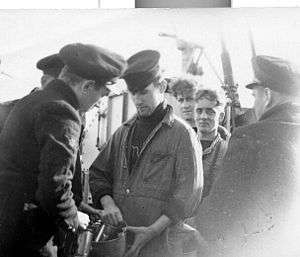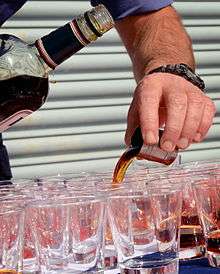Splice the mainbrace

"Splice the mainbrace" is an order given aboard naval vessels to issue the crew with an alcoholic drink. Originally an order for one of the most difficult emergency repair jobs aboard a sailing ship, it became a euphemism for authorized celebratory drinking afterward, and then the name of an order to grant the crew an extra ration of rum or grog.
History
Braces are the lines that control the angle of the yards. On the first rate men-o-war, the mainbrace was the largest and heaviest of all the running rigging; the mainbrace on HMS Victory is 5 inches (13 cm) in diameter.[1] Gunners commonly aimed for the ship's rigging during naval battles, with the mainbrace being the prime target. If the mainbrace was shot away, it was usually necessary to repair it during the engagement; the ship was unmaneuverable without it and would have to stay on the same tack. Even repairing it after the battle was a difficult job; the mainbrace ran through blocks, so it could not be repaired with a short splice or a knot. Splicing in a large run of hemp was strenuous work, and generally the ship's best Able Seamen were chosen to carry out the task under the supervision of the Boatswain ("bosun").[1] On completion of the task, it was customary for the men to be rewarded with an extra ration of rum. The Boatswain would take a sip from the ration of each of the men he had selected for task. Eventually the order to "splice the mainbrace" came to mean that the crew would receive an extra ration of rum, and was issued on special occasions: after victory in battle, the change of a monarch, a royal birth, a royal wedding or an inspection of the fleet.[2] In cases where the whole fleet was to receive the signal, it would be run up with a lift of flags or signalled by semaphore.[3]

A ration of rum a day was standard issue in the Royal Navy until 1970,[4] when concerns over crew members operating machinery under the influence led to the rum ration being abolished.[5] Restrictions were placed on those who could "Splice the mainbrace": any man or officer over the age of 20 who desired to take it received an extra issue of one-eighth of a pint of rum. Lemonade was issued those who did not wish for the rum. The rum was mixed with water to make grog for all ratings below Petty Officer. Only ratings marked "G" (for Grog) in the ship's books could draw rum, grog or lemonade when the mainbrace was spliced and no payment in lieu was available. Those under 20 were marked "U.A." (for under age) in the ship's book; they were similarly barred from drawing the daily rum ration. "T" stood for Temperance (for those of Temperance Movement). The issue of rum to wardroom and gunroom officers was stopped in 1881 and ended for warrant officers in 1918; splicing the mainbrace was the only time that officers could be issued with rum.[1]

Other navies abolished the grog allowance far earlier (the United States Navy after the American Civil War),[6] but the order persisted, allowing the crew to take another drink in place of rum or grog; in 1845 it is recorded as being substituted for the more rowdy "Crossing the Line" ceremony.[7] The Royal New Zealand Navy was the last navy to issue junior and senior ratings a daily tot of rum, issuing its last daily rum ration on 1 March 1990. Today the Royal Canadian Navy is more generous with the allowances, allowing crew members to take 87.5 millilitres (3.08 imp fl oz; 2.96 US fl oz) of spirits compared with the 62.5 millilitres (2.20 imp fl oz; 2.11 US fl oz) allowed by the Royal Navy, although the Royal Navy does make allowance for paucity of supplies, permitting two 350 millilitres (12 imp fl oz; 12 US fl oz) cans of beer to be issued if commercial spirits are not available.[8][9]
The order "Splice the Mainbrace" was still popular with some of the U.S. Navy's submarine fleet during WWII. On USS Barb,[10] a skipper on combat patrols in WWII, during the boat's 8th and 9th missions in 1944, did in fact announce on the 1MC "Splice the Mainbrace" after each successful attack and sinking of a Japanese ship. On Barb 's 8th combat patrol, the skipper promised the sinking of 5 ships; Barb delivered. After each sinking the Skipper had a special cake made and each sailor was granted a shot of rot gut whiskey. On the 9th patrol, the Skipper was able to sneak 24 cases of beer aboard which was distributed after each of Barb's successful attacks.[11]
Permission to issue the order to splice the mainbrace is heavily restricted; the Royal Navy allows only the Queen, a member of the Royal Family, or the Admiralty Board to do so;[9] the Royal Canadian Navy permits the Queen, the Governor General of Canada, or the Chief of the Defence Staff to issue it.[8] When the Mediterranean fleet received the order from the Prince of Wales (the future Edward VIII) in 1932 it was the first time it had happened since 1918; it was accompanied by the order to "Mend and make clothes", another archaic signal which grants the crew a half-day holiday.[12] Ships in most of the victorious fleets received the order at the end of the Second World War;[13] one ship received the order while still under attack.[3] King George VI issued the order in 1949 to the crew of HMS Amethyst after the Yangtse Incident.[14] It was ordered on the day of Queen Elizabeth's coronation in 1953, on 29th July 1981 for the wedding of Prince Charles and Lady Diana Spencer and of Prince William's birth on 21 June 1982, when "Splice the Mainbrace" was celebrated in the Fleet just one week after the end of the Falklands War. Nowadays, when rum is no longer issued daily, the order is somewhat more freely given: the Queen issued it after her Golden Jubilee celebrations in 2002, after the Trafalgar 200 Fleet Review in 2005,[15] and after her Diamond Jubilee celebrations in 2012.[16]
In Canada, the order was most recently given by Queen Elizabeth II on 29 June 2010 at the conclusion of the International Fleet Review for the occasion of the Royal Canadian Navy's 100th Anniversary. She signalled:
It has given me great pleasure to return with the Duke of Edinburgh to Halifax, Nova Scotia, to witness the International Fleet Review celebrating the Centennial of Canada's Navy. Maritime Command has confirmed through the smartness of its people and ships, and superb execution of the International Fleet Review, the best traditions of service on the sea. I offer to all the officers, men and women of the Canadian Atlantic Fleet my congratulations. It is particularly pleasing to see the strong bonds forged by Canada's Navy with the Allied Navies gathered here today. May all visiting sailors and delegations return safely to their homeports with fond memories of this historic celebration. I know how greatly the dockyard and other supporting services have contributed to making this International Fleet review an occasion which I shall long remember. The Royal Canadian Navy can take great pride in the accomplishments of the past, in its ongoing service to Canada, and the Significant contribution to Security on the world's oceans. Prince Philip and I send our warm good wishes to all of you and look forward to following your important endeavors as you sail to meet the challenges of another century of service. Splice the mainbrace.— Elizabeth R[17]
References
- 1 2 3 "Navy Slang". Royal Navy. 2006. Retrieved 1 November 2006.
- ↑ "Ceremony and Traditions". Royal Australian Navy. Retrieved 5 September 2008.
- 1 2 "HMAS Nizam". Sea Power Centre Australia. 2006-04-08. Retrieved 5 September 2008.
- ↑ "Splicing the Mainbrace". Royal Navy. 2005-07-11. Retrieved 5 November 2006.
- ↑ Dan van der Vat (2004-05-20). "Obituary: Admiral of the Fleet Lord Hill-Norton". The Guardian. Retrieved 1 November 2006.
- ↑ C. L. Veit. "Integration in the US Navy". Naval Landing Party. Retrieved 1 November 2006.
- ↑ "Chaplain Walter Colton, USN, on United States frigate Congress, 10 Dec. 1845". Department of the Navy. Retrieved 1 November 2006.
- 1 2 "CFAO 36-35 -- Spirit Issue". Finance and Corporate Services Canada. 1989-08-04. Retrieved 1 November 2006.
- 1 2 "Supplementary Income" (PDF). UK Ministry of Defence. Retrieved 1 November 2006.
- ↑ Eugene B. Fluckey, 1992, "Thunder Below!: The USS Barb Revolutionizes Submarine Warfare in World War II"
- ↑ Eugene B. Fluckey (1992). "Thunder Below! The USS Barb revolutionizes submarine warfare in World War II". University of Illinois Press. Retrieved 5 January 2015.
- ↑ "The Princes on the Mediterranean". The Guardian. 1932-07-11. Retrieved 1 November 2006.
- ↑ Jerry Proc. "The End of Hostilities". Friends of HMCS Haida. Retrieved 1 November 2006.
- ↑ "Amethyst Crew Gets Royal Order to 'Splice Mainbrace'". The News and Courier. 1949-08-01. Retrieved 31 December 2011.
- ↑ "RRS James Clark Ross". British Antarctic Survey. 2005. Retrieved 1 November 2006.
- ↑ "Queen tells Navy to splice the mainbrace following Jubilee efforts". Navy News. 19 June 2012. Retrieved 19 June 2012.
- ↑ Message: 291215Z June 10, Subject: Splice the Main Brace, NDHQ CMS OTTAWA